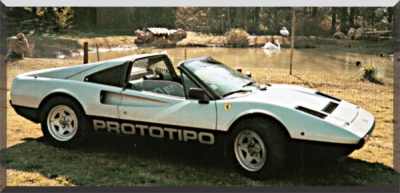SCM Analysis
Detailing
| Years Produced: | 1983-85 |
| Number Produced: | 3,042 |
| Original List Price: | $59,500 (1984) |
| SCM Valuation: | $30,000-$35,000 |
| Tune Up Cost: | $4,000 |
| Distributor Caps: | $378 (two required) |
| Chassis Number Location: | On the steering column, visible through windshield |
| Engine Number Location: | Right front of block |
| Club Info: | Ferrari Club of America, Box 720597, Atlanta, GA 30358; Ferrari Owners Club, 8642 Cleta St., Downey, CA 90241 |
| Website: | http://www.ferrariclubofamerica.org |
| Alternatives: | Maserati Ghibli or Boss 302 Mustang with self-applied “prototipo” sticker kit |
The car in question sold at the Poulain Le Fur auction in Monaco, May 25th, 2001, for $30,633 including buyer’s premium and VAT of 17.94%.
I am not exactly what you would call a fan of 308s. There is nothing inherently wrong with them, but Fiat cranked them out like there was no tomorrow, over 10,000 in all. To me a 308 is just another late-model used car, with a good potential for astronomic maintenance and equally high-priced repairs.
The car at hand is described as a 1982 “Prototipo” GTS QV, built in 1981, supposedly the first 308 to have the four-valve engine that Ferrari designed to make up for the power lost to emission controls.
This car’s history reeks of intrigue, danger, gangsters and a touch of the daytime soaps. Its story (dare I call it a provenance?) is fascinating. Initially stolen from the factory. First “owner,” a gangster from Marseille, is killed. The second owner is an automotive repair shop proprietor in Corsica. (In my experience there is little difference between the former owner and the latter.) After this, the ownership story becomes banal and less interesting.
I have some problems with the catalog’s description, though. Normally Poulain’s write-ups are precise and documented. This one, about the “prototipo,” is not. The whole story is based on an old article in a French magazine, without any of the usual verifications. One might think that Ferrari would provide some information about a prototype stolen from its factory; surely this isn’t a frequent occurrence.
The catalog description goes on to paraphrase the article, saying that a 1981 308 chassis received this first experimental QV engine, which had magnesium castings, and produced more power than the production engine. Which castings are magnesium? Are we talking about the timing chain cover, the water pump, the cam covers or the whole block? How much extra horsepower and why? A few more ponies or a whole bunch? Not only is the catalog silent on these issues, but also the dreaded words “the owner says” are used at the end of the article to substantiate the higher horsepower claim. We here in the States often hear this ugly “owner says” expression, but this is the first time in more than ten years of reading Poulain’s catalogs that I have seen them use it.
But back to the car itself. It looked like a nice used car. The claimed mileage of 38,000 km (23,750 miles) is believable. Of course, every 308 for sale in the world also seems to have less than 30k miles on the clock. Since there was no mention of service records, it will be ready shortly for the dreaded and expensive ($4,000) 30,000-mile service.
Overall, the cosmetics were nice enough, although a black vinyl strip, going the full length of the rockers, proclaimed “PROTOTIPO” in foot-tall letters. This monument to bad taste is something only a Middle Eastern nouveaux riche would dare. The audience did not pay much attention to the “Prototipo” hoopla either, the car sold for about the market price of a normal four-valve.
Was it a good buy? I don’t have a clue. I wish the best of luck to the new owner. May he have the good taste to remove the phony vinyl strip; may he have the additional good fortune to remove it cleanly, without need for repaint. May the 30,000-mile service reveal no expensive surprises. May he enjoy the car. My advice to him is to hang on to the catalog and find a copy of the original magazine article. Without them, the car’s great story is just another tall tale that gets repeated at the café, late at night after one too many glasses of Bordeaux.
(Historical data and photo courtesy of auction company.)
